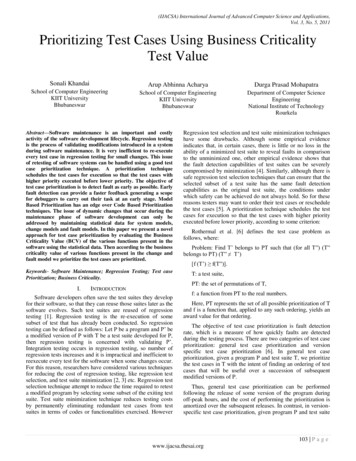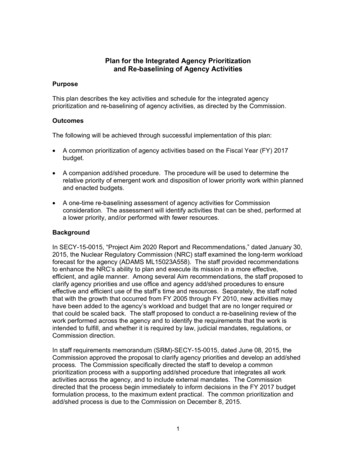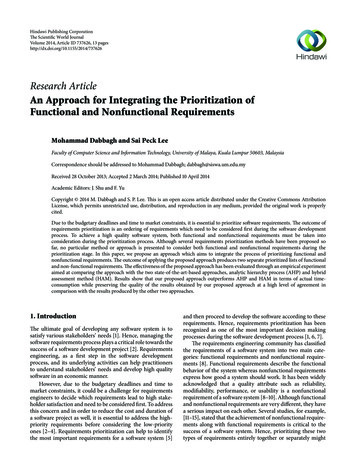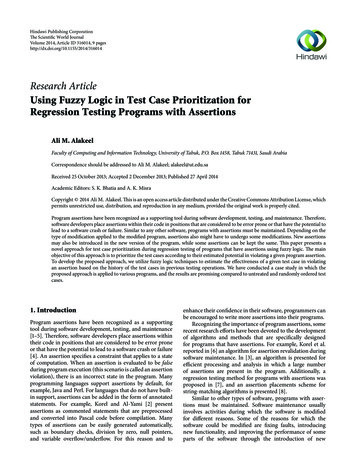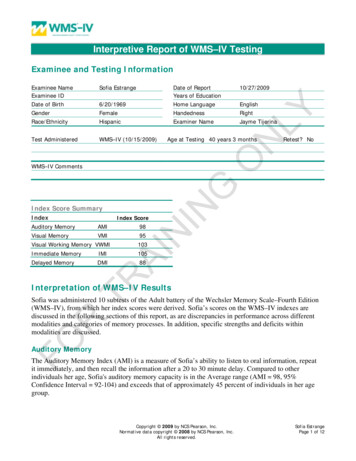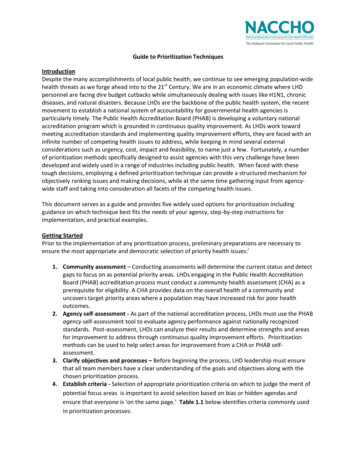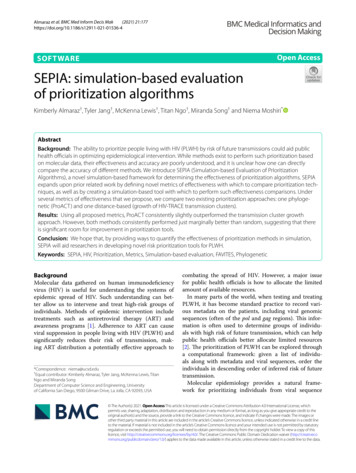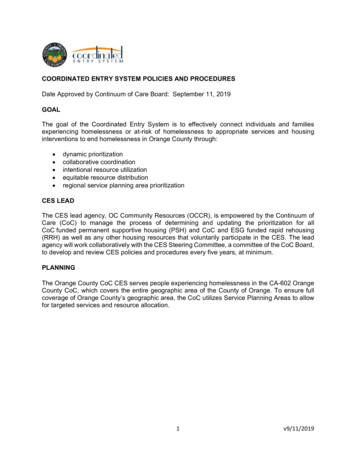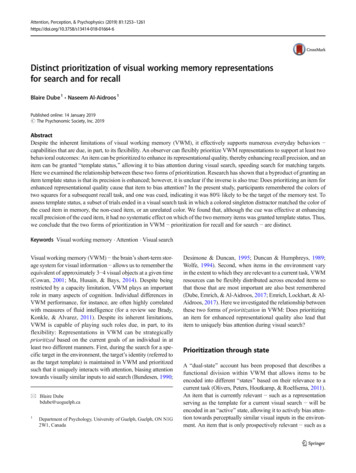
Transcription
Attention, Perception, & Psychophysics (2019) 1664-6Distinct prioritization of visual working memory representationsfor search and for recallBlaire Dube 1 & Naseem Al-Aidroos 1Published online: 14 January 2019# The Psychonomic Society, Inc. 2019AbstractDespite the inherent limitations of visual working memory (VWM), it effectively supports numerous everyday behaviors capabilities that are due, in part, to its flexibility. An observer can flexibly prioritize VWM representations to support at least twobehavioral outcomes: An item can be prioritized to enhance its representational quality, thereby enhancing recall precision, and anitem can be granted Btemplate status, allowing it to bias attention during visual search, speeding search for matching targets.Here we examined the relationship between these two forms of prioritization. Research has shown that a byproduct of granting anitem template status is that its precision is enhanced; however, it is unclear if the inverse is also true: Does prioritizing an item forenhanced representational quality cause that item to bias attention? In the present study, participants remembered the colors oftwo squares for a subsequent recall task, and one was cued, indicating it was 80% likely to be the target of the memory test. Toassess template status, a subset of trials ended in a visual search task in which a colored singleton distractor matched the color ofthe cued item in memory, the non-cued item, or an unrelated color. We found that, although the cue was effective at enhancingrecall precision of the cued item, it had no systematic effect on which of the two memory items was granted template status. Thus,we conclude that the two forms of prioritization in VWM prioritization for recall and for search are distinct.Keywords Visual working memory . Attention . Visual searchVisual working memory (VWM) the brain’s short-term storage system for visual information allows us to remember theequivalent of approximately 3 4 visual objects at a given time(Cowan, 2001; Ma, Husain, & Bays, 2014). Despite beingrestricted by a capacity limitation, VWM plays an importantrole in many aspects of cognition. Individual differences inVWM performance, for instance, are often highly correlatedwith measures of fluid intelligence (for a review see Brady,Konkle, & Alvarez, 2011). Despite its inherent limitations,VWM is capable of playing such roles due, in part, to itsflexibility: Representations in VWM can be strategicallyprioritized based on the current goals of an individual in atleast two different manners. First, during the search for a specific target in the environment, the target’s identity (referred toas the target template) is maintained in VWM and prioritizedsuch that it uniquely interacts with attention, biasing attentiontowards visually similar inputs to aid search (Bundesen, 1990;* Blaire Dubebdube@uoguelph.ca1Department of Psychology, University of Guelph, Guelph, ON N1G2W1, CanadaDesimone & Duncan, 1995; Duncan & Humphreys, 1989;Wolfe, 1994). Second, when items in the environment varyin the extent to which they are relevant to a current task, VWMresources can be flexibly distributed across encoded items sothat those that are most important are also best remembered(Dube, Emrich, & Al-Aidroos, 2017; Emrich, Lockhart, & AlAidroos, 2017). Here we investigated the relationship betweenthese two forms of prioritization in VWM: Does prioritizingan item for enhanced representational quality also lead thatitem to uniquely bias attention during visual search?Prioritization through stateA Bdual-state account has been proposed that describes afunctional division within VWM that allows items to beencoded into different Bstates based on their relevance to acurrent task (Olivers, Peters, Houtkamp, & Roelfsema, 2011).An item that is currently relevant such as a representationserving as the template for a current visual search will beencoded in an Bactive state, allowing it to actively bias attention towards perceptually similar visual inputs in the environment. An item that is only prospectively relevant such as a
1254representation that may serve as a template for a later searchtask or as the object of an upcoming memory test, however,will be encoded in an Baccessory state, in which it cannotinteract with attention until it becomes relevant.The functional distinction between these two states isthought to be a result of the prioritization of the currentlyrelevant item. Gunseli et al. (2014), for instance, measuredtwo electrophysiological markers of VWM maintenance during a working memory task: Contralateral delay activity(CDA), reflecting the quantity of stored information, and thelate positive complex (LPC), reflecting cognitive effort. Incomparing these components across conditions in which themaintained item was used as a search template versus when itwas used for simple recognition, they noted that both representations elicited a CDA, but they differed in the extent towhich they elicited an LPC. The authors concluded that,though the representations were both stored in VWM, thesearch template was prioritized such that greater effort wasinvested in its maintenance. Similarly, a study directly comparing the electrophysiological profiles of currently versusprospectively relevant search templates was also consistentwith the prioritization of the current (active) template overthe prospective (accessory) item (de Vries, van Driel, &Olivers, 2017). Here, the researchers also noted no differencesin CDA amplitude between the two conditions; however, theyobserved stronger suppression of alpha band activity (8–14 Hzactivity; thought to reflect item selection and maintenance)contralateral to currently relevant memory items. The researchers concluded that, in addition to selection and maintenance, lateralized alpha power is also sensitive to the relativepriority of VWM representations for search. Thus, the functional differences between active and accessory VWM representations are thought to be a byproduct of their relativepriority.Prioritization through resourcesThe priority of items within a memory array is typicallydetermined following clear task instruction, such as explicitly assigning an item template status (Carlisle, Arita,Pardo, & Woodman, 2011; de Vries et al., 2017; Rajsic,Ouslis, Wilson, & Pratt, 2017; Vickery, King, & Jiang,2005; Woodman & Arita, 2011), or using cues to identifythe item(s) most likely to be the object of a subsequentmemory test (Dube et al., 2017; Emrich et al., 2017;Hollingworth & Hwang, 2013; van Moorselaar,Theeuwes, & Olivers, 2014, Experiment 4). Recently, ithas been shown that identifying an item as a template foran upcoming search not only causes that item to biasattentional selection, but it also causes that representationto be encoded with greater precision than those items thatare accessory (Rajsic et al., 2017). Across twoAtten Percept Psychophys (2019) 81:1253–1261experiments, Rajsic et al. (2017) had participants encodetwo colored forms for a subsequent memory test, and acue indicated which of the two items should serve as thetemplate for an intervening search task requiring apresent/absent judgment. The researchers showed thatthe cued item was remembered with greater precision,suggesting that search templates received a greater shareof VWM resources.Identifying an item as most likely to be probed in an upcoming memory test has a similar effect on memory performance. In our recent work, we assigned priority to items in amemory array by using spatial (Emrich et al., 2017) andfeatural (Dube et al., 2017) cues to indicate which items weremost likely to be probed in the upcoming memory test. Whenan item was cued (i.e., identified as high priority), this signaledto the participants that it would serve as the relevant item on anabove-chance proportion of but not all trials, incentivizingthe maintenance of the full set of items, and allowing for recalltests of both prioritized and non-prioritized items.Manipulating the probabilities assigned to these cues has reliable effects on memory performance: High priority items bothare more likely to be successfully encoded into VWM, and areencoded with greater precision relative to lower priority items(Dube et al., 2017; Emrich et al., 2017). Specifically, VWMresources are distributed amongst the items as a function oftheir priority such that the most relevant items receive a largershare of the resources and are thus better remembered.The current studyPrioritization in VWM takes at least two forms. An item canbe prioritized by representing it in an active state, whilerepresenting concurrently maintained items in an accessorystate. For example, assigning an item to be the template in avisual search causes that item to be represented in the activestate, and biases attention towards matching representations(known as attentional capture). A representation can also beprioritized by assigning it a greater proportion of resourcesthan concurrently maintained representations. For example,using a cue to indicate which item is most likely to be probedfor recall causes it to be remembered more precisely. What isthe relationship between these two forms of prioritization?While the results of Rajsic et al. (2017), showing thatassigning an item template status both causes that item to biasattention and enhances the precision with which it is remembered, suggests a 1-to-1 relationship, such a conclusion isunwarranted until the reverse is also evaluated. Indeed, thereis some evidence that the process of remembering an item forsearch (i.e., as a search template) is different to the processassociated with VWM storage for recall (Carlisle &Woodman, 2011; Olivers & Eimer, 2011).
Atten Percept Psychophys (2019) 81:1253–1261This reverse relationship was partially assessed byHollingworth and Hwang (2013). They used a retro-cue with80% validity to indicate which of two memory items shouldbe prioritized for recall, and evaluated both recall performanceand capture by various singletons in an intervening searchtask. They found that the cued item was more likely to besuccessfully recalled during the memory test, suggesting thecue altered priority for recall. They also found that there wasno difference in search times when the singleton matched thecolor of the non-cued memory item relative to a novel color,suggesting the non-cued item was represented in an Baccessory state in memory. Thus, one interpretation of these results isthat de-prioritizing a memory item for recall also causes thatitem to be de-prioritized for search (i.e., represented in anaccessory state). Hollingworth and Hwang did not, however,observe any differences in the precision of the cued and noncued representations in memory, nor did they measure theeffects of singletons matching the cued memory item. Assuch, it is unclear whether their cues actually affected priorityfor search, or if both memory items were represented in anaccessory state. Indeed, given that their cue was probabilisticin nature, it is likely that it did not affect priority for search (seeDube, Lumsden, & Al-Aidroos, 2018). Accordingly, in thepresent study we adjusted the paradigm used byHollingworth and Hwang to address this limitation, and directly tested whether cueing an item to be remembered moreprecisely also causes that item to bias attention.Across two experiments, we had participants encode thecolors of two simultaneously presented squares, while concurrently cueing the item that was most likely to be probedin a subsequent memory test. On a subset of trials, ratherthan probing memory, the trial ended with a visual searchtask in which a color-singleton distractor could eithermatch the identity of the high-priority (i.e., cued) item,the low-priority (i.e., non-cued) item, or could be novelto the trial. If cueing an item for recall also grants its representation template status, then we would observe greaterattentional capture (i.e., slower response times) in thesearch condition in which a distractor matched the colorof the cued item relative to when it matched the color of thenon-cued item. In line with our previous work, participantsremembered this high-priority item more precisely than thelow-priority item (Experiment 1) and performed better ontests of the high-priority item in a change detection task(Experiment 2); however, across both experiments, we observed no evidence that the VWM representation of thehigh-priority item biased attention to a greater degree thanthe low-priority representation. Thus, despite using the cueto prioritize representations in VWM, the provision of thecue did not also lead that item to uniquely bias attention. Infact, in both Experiment 1 and Experiment 2 we observedattentional biasing by both VWM representations independent of the cue.1255Experiment 1MethodsParticipantsForty-seven undergraduate students from the University ofGuelph between the ages of 18 and 27 years (M 20.22)participated for partial course credit. All participants providedinformed consent and reported having normal or corrected-tonormal vision and no color blindness.Stimuli and apparatusParticipants viewed experimental stimuli from a distance of 57cm, fixed with a head and chin rest. Stimuli were coloredsquares and white Landolt squares presented on a gray background via a 1,280 1,024 CRT monitor with a refresh rate of75 Hz. Colors were selected randomly from a 360 colorwheel, as in Dube et al. (2017), with the constraint that colorsdrawn on a given trial were separated by a minimum of 50 onthe wheel.ProcedureAn example trial is depicted in Fig. 1. Each trial began withthe 360-ms presentation of a memory array consisting of twocolored squares (1.2 in width and height) placed randomly intwo of eight possible locations spaced equally around an invisible circle with a diameter of 5.5 , with a line extendingfrom the central fixation point (0.07 radius) toward the itemthat was most likely to be probed in a subsequent memory test.The validity of the cue was 80%. Following a delay of 800 ms,jittered from trial-to-trial by 200 ms, the trial ended in one oftwo ways. On memory trials, the outlines of the two squaresreappeared on the screen, surrounded by a 360 color wheel.One of the two squares was probed (highlighted by a thickblack line), and participants were to click the color on thewheel that best corresponded with the color of the probed itemat initial presentation. On search trials, rather than a memorytest, the trial instead ended with a visual search task. On thesetrials, eight Landolt squares (0.44 in width and height) werepresented equally spaced in a circle around fixation (with thesame eccentricity as the memory array): seven were orientedsuch that their gaps appeared on either the top or the bottom,and one the target such that its gap was on either the left orthe right. Participants were to locate the target and indicate itsgap position via keypress response with their left hand. On amajority of the search trials, one of the search distractors appeared as a color singleton, the color of which either matchedthe high-priority item in memory (the cued item in the memory array), or the color of the low-priority item (the non-cueditem in the memory array), or was a novel color for that trial.
1256Atten Percept Psychophys (2019) 81:1253–1261Fig. 1 Example trial sequence. The trial ended in either a memory test or a visual search. The example shows a valid-cue memory trial, and a highpriority match search distractor. Actual stimuli were presented on a gray backgroundOn some trials, no singleton was presented. Overall, participants completed 540 experimental trials, 360 of which werememory trials and 180 were search trials (45 trials per each ofthe four singleton conditions: high-priority match, lowpriority match, novel, and no singleton).model and reported parameters: Pguess, SDMM, as well as thestandard deviation of the raw response distributions(SD response ), as an assumption free measure of VWMperformance.ResultsAnalysisHere we assess VWM performance using a three-parametermixture model (Bays, Catalao, & Husain, 2009) to decomposeparticipants’ raw response errors (i.e., the degree of distancebetween the color of the probed item and the participant’sresponse). This model asserts that there are three separatecomponents that contribute to such response errors: a uniformdistribution that reflects the proportion of random guesses(guess rate; Pguess); a von Mises distribution that reflects responses centered on the correct target color (the standard deviation of which is inversely related to representational precision; SDMM), and a von Mises distribution that reflects theproportion of responses centered around the non-probedmemory item (i.e., swap trials; P swap ). Errors weredecomposed using Maximum Likelihood Estimation viaMATLAB and the MemToolBox library (Suchow, Brady,Fougnie, & Alvarez, 2013). It is worth noting that a numberof models have been proposed to decompose data such asthese (van den Berg, Shin, Chou, George, & Ma, 2012;Zhang & Luck, 2008). While the differences between thesemodels are critical when evaluating questions about the architecture of VWM and its capacity, in the present study ourquestion instead surrounds the effects of different forms ofprioritization. As such, our analyses of participants’ recall performance primarily uses the most commonly implementedWe removed participants based on separate memory andsearch performance criteria. We removed participants forwhom memory data in one or more condition had a modelfit characterized as an outlier. Specifically, we removed modelestimates if SDMM fell above 105 (i.e., the value associatedwith random color selection). Given that the removal of asingle condition resulted in the loss of 50% of a participant’sdata (i.e., the outlying SDMM estimate and correspondingPguess estimate), a single outlying model fit necessitated theremoval of all of the participant’s data. This resulted in theremoval of eight participants. Further, we removed participants with a search error rate above 40%, resulting in theremoval of an additional five participants. Analyses were carried out on a final sample of 34 participants.Memory performanceWe compared memory performance on validly cued trials(i.e., trials that probed the high-priority item) versus invalidlycued trials (i.e., trials that probed the low-priority item) acrossSDresponse as well as all three model parameters: Pguess, SDMM,and Pswap. The standard deviations of the raw response distributions (SDresponse) corresponding to trials that probed thehigh- (M 38.26, SE 2.47) versus low-priority (M 46.05, SE 2.86) memory item for recall differed significantly,
Atten Percept Psychophys (2019) 0.150.1019.018.518.00.0517.50.0017.0High PriorityHigh PriorityLow PriorityProbe TypeLow PriorityProbe TypeFig. 2 Guess rate (Pguess) and standard deviation (SDMM) results from thethree-parameter mixture model. (a) Probability of a random guess forhigh- vs. low-priority items. (b) Standard deviations across probe types.Here, high and low priority refer to the items that were most and leastlikely to be probed for recall, respectively. Error bars in all figuresrepresent adjusted within-subject standard error (Morey, 2008)t(33) -3.846, p .001, such that variability was greater (and,thus, precision was lower) in the low-priority probe condition.Parameter estimates for Pguess as well as SDMM also differedsignificantly between high- and low-priority items (Fig. 2aand b, respectively). Specifically, Pguess was significantly lower when participants were asked to recall the high-priority itemthan when asked to recall the low-priority item, t(33) -2.96,p .01. Similarly, SDMM estimates were significantly lowerwhen participants were asked to recall the high-priority itemthan when asked to recall the low-priority item, t(33) -2.41,p .022. On average, Pswap (i.e., the mistaken reporting of thecolor of the non-probed item) accounted for less than 1% of alltrials, and did not significantly differ for high- and lowpriority trials, t(33) -0.61, p 0.55. Thus, as predicted,participants were able to use to the cue to prioritize the relevant item such that it was more likely to be encoded, and moreprecisely remembered, than the low priority item.participant to 2.5 standard deviations of the conditionmean, resulting in the loss of, on average, 1% of trials.We subjected search reaction times on correct trials to afour-way (Singleton Condition: High Priority Match, LowPriority Match, Novel, and No Distractor) repeated measures ANOVA, yielding a significant main effect ofdistractor type, F(3,33) 3.07, p 0.031, ηp2 0.085.Individual t-tests yielded no statistically significant difference between the high-priority match (M 0.993, SE .123) and low-priority match (M 0.995, SE .133)search conditions, t(33) -0.132, p 0.896. Reactiontimes in the high-priority match condition differed statistically significantly from both the novel condition, t(33) 2.04, p .049, and the no-distractor condition, t(33) 1.90, p .050, as did reaction times in the low-prioritymatch condition; t(33) 2.04, p .048, and t(33) 2.88,p .007, respectively. Thus, we observed no evidencethat the high- and low-priority items in memory differedin the extent to which they interacted with attentionalselection during search. To more fully assess the null difference between high- and low-priority matching searchconditions, we conducted a Bayesian t-test using the recommended priors (JASP Team, 2018; Rouder, Speckman,Sun, Morey, & Iverson, 2009) that compared the nullAccuracy Overall, search target discrimination accuracy washigh (M 91.34%). A four-way (Singleton Condition: HighPriority Match, Low Priority Match, Novel, and NoDistractor) repeated measures ANOVA on accuracy scoresyielded no significant main effect of singleton condition,F(3,33) 1.492, p 0.221. As such, accuracy did not systematically vary by condition (see Table 1 for a summary).Reaction times See Fig. 3 for a summary of reaction times.We trimmed visual search reaction times for eachTable 1 Mean target detection accuracy (and SD) across conditions andexperiments (%)1.011.00Reac on Time (s)Visual Search0.990.980.970.960.95Singleton conditions0.94Experiment HP MatchLP MatchNovelNo DistractorHP MatchLP MatchNovelNo DistractorSingleton Condi on1293.88 (0.05) 92.37 (0.07) 93.04 (0.06) 91.67 (0.07)92.10 (0.08) 93.33 (0.08) 93.70 (0.08) 94.40 (0.09)Fig. 3 Reaction times across all singleton conditions in Experiment 1:high-priority (HP) match, low-priority (LP) match, novel, and nodistractor
1258model against the alternative, and found a Bayes factor(BF01) of 5.40, providing converging evidence that thecue in the present study did not alter priority for search.DiscussionThe results of Experiment 1 suggest that, although the cueditem in the memory array was effectively prioritized for recall,as evidenced by enhanced memory performance on tests ofthe cued representation, the cue did not determine which representation would guide subsequent attention. That is, we observed no differences between response times on highpriority-match and low-priority-match singleton distractorconditions. Notably, however, we also observed no statistically significant difference between response times between novel and no-distractor search conditions, suggesting that perhapswe did not have enough stimulus energy to observe capture inthe novel search condition. As such, we conductedExperiment 2 to replicate the main findings fromExperiment 1, and to assess whether increasing the contrastbetween singletons and the display background would lead tothe more conventional finding that even novel distractorssomewhat capture attention.Experiment 2MethodsMethods for Experiment 2 were identical to those ofExperiment 1 with the exceptions noted below.ParticipantsParticipants were a new set of 40 undergraduate students fromthe University of Guelph between the ages of 17 and 22 years(M 18.27).Stimuli and apparatusExperimental stimuli remained the same; however, the background was changed to black and search stimuli (Landoltsquares) were changed to gray. Responses were collected viaan Xbox gamepad controller for maximal response timesensitivity.Procedure and analysisEach trial in Experiment 2 began the same way as inExperiment 1 (i.e., with the presentation of a two-itemmemory array and simultaneous cue that was 80% valid).Trials ending in a visual search task were also unchangedfrom Experiment 1. Trials ending in a memory test,Atten Percept Psychophys (2019) 81:1253–1261however, were adjusted such that participants completeda change-detection task instead of the partial report taskdetailed in Experiment 1, and change-detection accuracyserved as our measure of memory performance. We optedto switch to a change-detection task in order to increasepower in our design: Given that participants can respondmuch more quickly in this task, we were able to increasethe number of trials in the experiment. This change alsoafforded us the ability to collect responses via the Xboxcontroller rather than a mouse, which allowed for greatersensitivity in recording response times.On memory trials, 600 1,000 ms after the removal ofthe memory array, the originally presented squaresreappeared in the same spatial locations as at initial presentation. One of the squares was only an outline, and theother was colored in. On 50% of memory trials, this colorwas the same as it was at initial presentation (no changetrials), and on the other 50% of trials it was instead filledin with a color selected 30 from its original color on thecolor wheel (change trials). Participants were instructed toindicate if this color had changed since its initial presentation via button-press response on an Xbox gamepadcontroller. On search trials, participants used the rightand left bumpers on the gamepad to indicate gap locationon the target item, and on memory trials participants usedthe ‘A’ and ‘B’ buttons to indicate no change or change initem color, respectively. Participants completed a total of600 trials, 200 of which ended in a search task (50 trialsper singleton distractor condition).ResultsWe again removed participants based on separate visualsearch and memory performance criteria. We removedparticipants with greater than 40% error rates on thechange detection trials, resulting in the removal of fourparticipants. The threshold for removal based on visualsearch error rates was the same as in Experiment 1 (i.e.,40%), and resulted in the removal of an additional eightparticipants. Analyses were carried out on a final sampleof 28 participants.Memory performanceSee Fig. 4a for a summary of change detection results. Wecompared change detection accuracy on valid trials (i.e.,trials on which the high-priority, or cued, item in memorywas probed at test) and invalid trials (i.e., trials on whichthe low-priority, or non-cued, item in memory was probedat test). A paired samples t-test indicated that accuracy onvalid trials (M 75.40, SE .01) was statistically significantly greater than accuracy on invalid trials (M 69.50,SE .02), t (27) -5.05, p .001. Thus, as in Experiment
Atten Percept Psychophys (2019) 81:1253–126112591, the cued representation was effectively prioritized foruse in the memory test.in the present study did not alter priority for search. Thus, weagain observed no evidence that the high- and low-priorityitems in memory differed in the extent to which theyinteracted with attentional selection during search.Visual searchAccuracy Overall, search target discrimination accuracy washigh (M 93.36%). A one-way (Singleton Condition: HighPriority Match, Low Priority Match, Novel, and NoDistractor) repeated measures ANOVA on accuracy scoresyielded no significant main effect of singleton condition,F(3,27) 1.09, p 0.355. As such, accuracy did not systematically vary by condition (see Table 1 for a summary acrossboth experiments).General discussionAcross two experiments we demonstrate that the prioritizationthat underlies granting an item template status in VWM is notthe same as assigning high priority to an item for an upcomingmemory test. Despite having similar effects on memory performance, prioritizing a representation for recall does not inherently grant that item template status in VWM. That is, a cuesignaling which item is most relevant for a memory test doesnot determine which representation will guide attention.Reaction times See Fig. 4b for a summary of reaction times.We trimmed visual search reaction times for each participantto 2.5 standard deviations of the condition mean, resulting inthe loss of, on average, 1% of trials. We again subjectedsearch reaction times on correct trials to a four-way(Singleton Condition: High Priority Match, Low PriorityMatch, Novel, and No Distractor) repeated measuresANOVA, yielding a significant main effect of distractor type,F(3,27) 13.90, p 0.001, ηp2 0.34. A t-test yielded nostatistically significant difference between the high-prioritymatch (M 1.08, SE .03) and the low-priority match (M 1.07, SE .03) search conditions, t(27) 0.45, p 0.656.Reaction times in the high-priority match condition differedstatistically significantly from both the novel condition (M 1.04, SE .03), t(27) 2.73, p .011, and the no-distractorcondition (M 1.01, SE .03), t(27) 5.95, p .001, as didreaction times in the low-priority match condition; t(27) 2.02, p .05, and t(27) 5.31, p .001, respectively.Reaction times in the novel distractor condition were statistically significantly longer than in the no-distractor condition,t(27) 3.17, p .004. To more fully assess the null differencebetween high- and low-priority matching search conditions,we again c
these two forms of prioritization in VWM: Does prioritizing an item for enhanced representational quality also lead that item to uniquely bias attention during visual search? Prioritization through state A Bdual-state account has been proposed that describes a functional division within VWM that allows items to be
